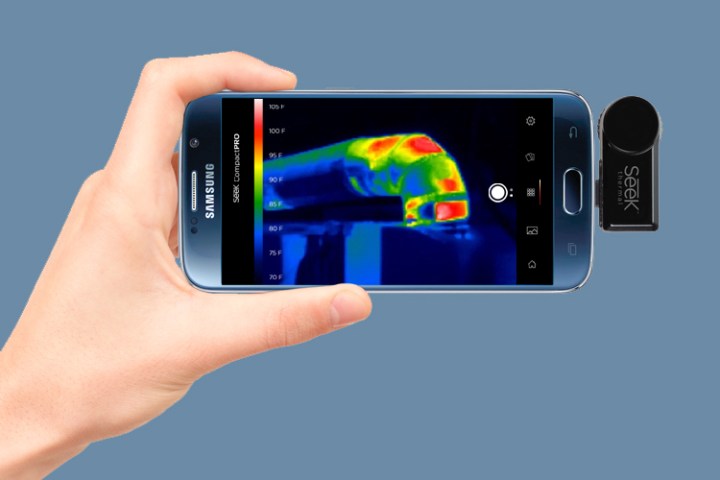
Sure, the CAT S60 has built-in thermal imaging, but for those not crazy about the construction-like fashion statement, thermal imaging will soon be available on any smartphone with the Seek add-on. An update to the pricier and larger Seek Thermal Camera, the Seek CompactPro is the first add-on thermal camera with a 320 x 240 sensor array, according to the manufacturer.
The Seek CompactPRO weighs less than half an ounce and can plug into any Android or iOS camera. The compatible app allows users to see the thermal readout from the add-on’s sensor from -40 to 625 degrees Fahrenheit, and from up to 1,800 feet away. The lens gives the thermal cam a 32-degree field of view.
At a bit under $500, the thermal camera is no toy, but it’s much more affordable than most thermal cameras, used professionally in construction and other fields. The app will also see an update allowing for storing thermal images in the radiometric file format –creating a 76,800 pixel image to analyze later with all the temperature details.
“High performance thermal imaging tools used to be expensive, difficult to carry, and primarily used by few people in large industrial facilities,” said Seek Thermal’s CMO/VP of Global Marketing Tracey Benson. “It is one of the most important sensing technologies that can prevent costly damages, increase productivity, and help avoid dangerous situations in hundreds of applications. If we can make it more affordable to find problems faster and easier with high-performance imaging quality in portable size devices, we are succeeding at our mission. Our aim is to fit everyone’s budget and put smart tools into the hands of more people who can really use it.”
Compared to the original Seek Thermal Camera, the latest version has a higher resolution and smaller design, but comes at a bit higher price.
Editors' Recommendations
- What they don’t tell you about wearing a camera on your face
- How to turn your old phone into a security camera
- I added a ridiculous $300 camera to my smartphone, and loved it
- This is what happens when you compare 4 phones in an 800MP camera test
- I adore the OnePlus 11 camera — but not for the reason you think




